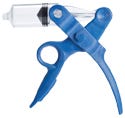Syringe Gives Boost to Contrast Media Injection
Tweaking a supplier’s valve resulted in enhanced comfort for prosthetics patients
May 1, 2008
Originally Published MPMN May 2008
ENGINEERING EXCELLENCE
Syringe Gives Boost to Contrast Media Injection
|
Designed for contrast media injections, the PowrSyringe is capable of an injection that is between 20 and 100% faster than a standard control syringe. |
Nothing beats the need for speed when it comes to contrast media injections. Fast contrast media injections can improve image quality—thus reducing the possibility of misdiagnosis—and can enhance the safety of both the patient and the physician.
The PowrSyringe, manufactured by Pinyons Medical Technology Inc. (Park City, UT; www.pinyonsmedical.com), is capable of injections that are between 20 and 100% faster than a standard control syringe, according to Shawn Fojtik, company president and CEO. Faster angiographic injections can reduce the amount of contrast media used, and, in turn, promote increased patient safety.
“If [the syringe] injects too slowly, a doctor tends to give more contrast to compensate or to give a second injection,” Fojtik explains. “It becomes a very important patient safety benefit because approximately 10–15% of all patients who have a coronary angiogram are susceptible to renal failure due to too much contrast media.” Studies suggest that reducing the volume of contrast agents required for injection by 10–20% could significantly decrease the risk of contrast-induced nephropathy; that condition can prolong hospital stays and even lead to death.
Faster injection speeds could also benefit physicians in the long term. Recent in vivo testing supports that the faster injection speed achieved by the PowrSyringe could ultimately save an interventional cardiologist an estimated hour and a half each year of direct exposure to cine x-ray radiation, according to Fojtik.
But in order to live up to the possibilities it presented for the marketplace, the PowrSyringe first demanded a design that facilitated the quick administration of contrast media, while simultaneously emphasizing safety and ergonomics. Pinyons enlisted the help of Integrated BioSciences Inc. (IBS; Lewisberry, PA; www.ibiosci.com) and The Tech Group, a West Pharmaceutical Services Co. (Montgomery, PA; www.westpharma.com) to incorporate all of these elements into a manufacturable design.
Stemming from its close work with B. Braun Medical, IBS had extensive experience with syringe and disposable applications, primarily for their assembly and packaging. The Tech Group contributed solid-model 3-D CAD product engineering to the project, in addition to producing rapid prototype units manufactured using a combination of SLA, machined-plastic, metal-forming, and compression-molding techniques, according to Ron Bell, who served as the firm's project manager for the PowrSyringe. “[Both companies’] contributions were huge in helping to realize the basic complicity, safety, and usability of the product,” Fojtik notes.
Although it reentered the project for the assembly stage, IBS originally coordinated with The Tech Group to bring the PowrSyringe through the initial concept and development phase. “The industrial design of the product had been fairly well developed without consideration for the mechanical and manufacturability needs,” explains Bell. “Significant iterative compromise efforts were required to arrive at the finished design that was aesthetically, ergonomically, functionally, and mechanically acceptable, yet still suitable for cost-efficient, large-volume automated commercial manufacturing.”
Pinyons approached Globe Medical Tech Inc. (Houston; www.globemedtech.com), a contract manufacturer specializing in disposables, to provide molding services in addition to product and manufacturing validations. Globe was able to simultaneously mold several product sizes quickly and economically in order to get the product ready for initial user feedback. In addition, Globe helped to identify a low-cost and effective material, along with other molding enhancements, for the syringe handle that could withstand the high pressure and force necessary to achieve the fast injection rates that distinguish the product from its competitors.
Copyright ©2008 Medical Product Manufacturing News
You May Also Like


.png?width=300&auto=webp&quality=80&disable=upscale)
